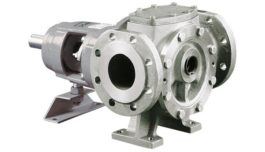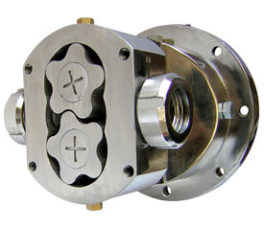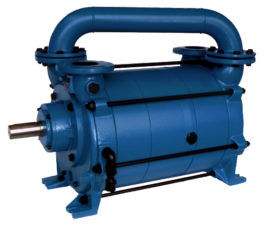Additional information
| Weight | 45 lbs |
|---|---|
| Dimensions | 36 × 20 × 20 in |
| Flow Rate (GPM) | 0-3, 0-7.5, 0-15, 0-30, 0-60, 0-120 |
| Connection Ends | NPT Threaded, Flanged, Triclamp |
$ 1,195.00 – $ 6,875.00
| Weight | 45 lbs |
|---|---|
| Dimensions | 36 × 20 × 20 in |
| Flow Rate (GPM) | 0-3, 0-7.5, 0-15, 0-30, 0-60, 0-120 |
| Connection Ends | NPT Threaded, Flanged, Triclamp |
Centrifugal pumps offer several advantages and disadvantages, which are important to consider for specific applications. Here are some of the key advantages and disadvantages of centrifugal pumps:
Centrifugal pumps can handle a wide variety of fluids, from thin liquids to viscous substances with suspended solids. They are used in industries such as manufacturing, oil and gas, chemical processing, water treatment, agriculture, and more.
Centrifugal pumps are known for their high efficiency in converting mechanical energy into fluid flow. Advances in pump design and technology have improved their efficiency, resulting in reduced energy consumption and operating costs.
Centrifugal pumps have a simple construction, which makes them easy to install and maintain. They typically have fewer moving parts compared to other types of pumps, resulting in less wear and tear and lower maintenance requirements.
Centrifugal pumps provide a continuous and steady flow of fluid, making them suitable for applications where a consistent supply of fluid is required. They can handle variable flow rates and adapt to changing system conditions.
Centrifugal pumps come in a range of sizes and capacities, allowing for scalability and flexibility in meeting diverse application requirements. They can be designed for low-flow residential applications or high-flow industrial applications.
Centrifugal pumps have a limited ability to lift fluids from a lower elevation or suction inlet. They require a positive suction head (PSH) to prevent cavitation and maintain proper operation. If the suction head is insufficient, additional equipment such as a foot valve or a priming mechanism may be required.
While centrifugal pumps can generate moderate to high heads, they are generally not suitable for extremely high-pressure applications. For such cases, reciprocating pumps or specialized high-pressure pumps may be more appropriate.
Cavitation can occur in centrifugal pumps if the pressure at the impeller inlet drops too low, leading to the formation and collapse of vapor bubbles. This phenomenon can cause damage to the impeller and decrease pump efficiency. Proper system design and maintenance practices, including adequate NPSH (Net Positive Suction Head) calculations, can help mitigate cavitation risks.
Although centrifugal pumps can handle a range of viscosities, they are generally not as effective with highly viscous fluids. Thick or sticky substances can cause increased friction, reduced efficiency, and potentially damage the pump.
While some centrifugal pumps can be designed as self-priming, not all models possess this feature. Self-priming centrifugal pumps are equipped with mechanisms or designs that allow for automatic fluid retention and re-priming without external assistance. However, many centrifugal pumps require external priming or the presence of fluid in the pump casing before starting.
It is important to assess the specific requirements of an application and consider these advantages and disadvantages when selecting a centrifugal pump to ensure optimal performance and efficiency.
Centrifugal pumps serve a wide range of industries due to their versatility and ability to handle various fluid types and flow rates. Some of the industries that rely on centrifugal pumps for their fluid handling needs include:
Centrifugal pumps are extensively used in the oil and gas industry for applications such as crude oil transfer, pipeline boosting, well dewatering, and offshore platform operations. They play a crucial role in the extraction, transportation, and refining of oil and gas products.
Centrifugal pumps are commonly found in water and wastewater treatment plants, where they are used for tasks such as water supply, filtration, chemical dosing, sludge handling, and wastewater transport. They help ensure efficient and reliable operation of water treatment processes.
Chemical processing plants rely on centrifugal pumps for fluid transfer, mixing, and circulation of various chemicals and solvents. These pumps are designed to handle corrosive, abrasive, and toxic fluids encountered in chemical manufacturing and processing operations.
Centrifugal pumps have critical applications in the power generation industry, including cooling water circulation in thermal power plants, boiler feed water supply, condensate extraction, and ash slurry handling in coal-fired power plants. They provide an essential role in ensuring efficient and reliable power generation processes.
Many manufacturing industries depend on centrifugal pumps, including automotive, food and beverage, pharmaceuticals, pulp and paper, and textiles. These pumps are used for fluid transport, coolant circulation, lubrication, and various process-specific applications.
Centrifugal pumps play a significant role in mining and construction operations. They are used for dewatering mine shafts, slurry transfer, dust suppression, and water supply for construction sites.
Centrifugal pumps are widely used in agricultural applications, such as irrigation systems, water supply for livestock, and drainage for agricultural fields. They enable efficient water distribution, improving crop productivity and farm operations.
Heating, ventilation, and air conditioning (HVAC) systems in commercial buildings and residential complexes utilize centrifugal pumps for chilled water circulation, heat transfer, and boiler-feed water supply. They help maintain comfortable indoor environments and efficient operation of HVAC systems.
These are just a few examples of the many industries that rely on centrifugal pumps to meet their fluid handling needs. The versatility, efficiency, and reliability of centrifugal pumps make them indispensable in various sectors, ensuring smooth operations and the efficient transportation of fluids in diverse applications.
Only logged in customers who have purchased this product may leave a review.



Reviews
There are no reviews yet.